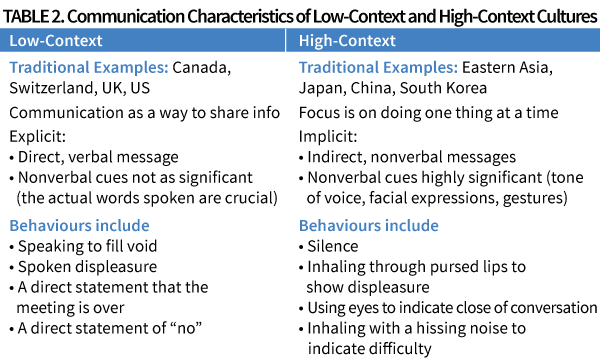In this article, Sharon M. Schweitzer delves into the intricacies of the global marketplace. She shares an eight-point introduction in cultivating communication skills and developing self-awareness to gain the cultural intelligence to make the “business of people” successful.
International business travel and globalisation increase with each passing moment, yet global negotiations and assignments can be challenging. For example, successful companies in the West, such as Ebay, Amazon and Google, have struggled in the Chinese marketplace. Creating a global mindset and developing cross-cultural communication skills are critical for business professionals.
Skills such as self-awareness, collaboration and cross-cultural perspectives are invaluable. To better communicate internally and externally, and achieve success in the global market, cross-cultural business strategies must be executed and integrated.
Developing Cross-Cultural Awareness Is Key
“The most interesting thing about cultures may not be in the observable things they do – the rituals, eating preferences, codes of behaviour, and the like – but in the way they mold our most fundamental conscious and unconscious thinking and perception.”
– Ethan Watters, “We Aren’t the World”1
Thinking is Not Universal
There are a multitude of erroneous assumptions surrounding the existence of culture. Many believe that there are universal ways of functioning as humans, humanity-wide avenues of thought, emotion and behaviour. However, extensive anthropological, business and psychological studies have proven this to be untrue. For example, one cultural dimension that must be accounted for in business revolves around the issue of uncertainty avoidance by measuring the extent to which people across 76 countries and regions “feel uncomfortable with uncertainty, ambiguity, the new, unknown and surprising”.2 The higher the score, the more the culture is uncomfortable with uncertainty. Scores on the uncertainty avoidance dimension range from cultures like Greece and Portugal, which scored 112 and 104 respectively, to Singapore and Jamaica, which scored 8 and 13 respectively. As this illustrates, there are considerable variations of tolerance of uncertainty and ambiguity worldwide. To assert that there are universal ways of handling risk and uncertainty is misleading.
To succeed in the global marketplace, all employees, from entry-level to business executives, must understand the importance of culture in navigating the “business of people”. Succeeding in the eastern hemisphere creates the opportunity to observe cultural cues, bridge gaps between cultures, implement appropriate strategies, and value the underlying industry of all business – the cultural microcosm of individuals.
Global Business Strategies for Success
To bridge cultures and succeed in the global business of people, it is imperative to establish concrete business strategies that provide structure. By creating a documented plan for your organisation, unified perspectives and actions in an unfamiliar territory can help employees conduct business smoothly. The following strategies revolve around the notion that research, respect and relationships are inescapable properties of global business strategy, particularly in Asia.
[ms-protect-content id=”9932″]Cultural education is key when engaging with Asian and/or global business counterparts. From leadership to sales representatives, ensure all employees interacting internationally are cross-culturally trained, and have a self-awareness profile, as well as country-specific briefings. Depending on your industry, financial situation and accessibility to training, education can range from reading a cross-cultural guide, such as Access to Asia: Your Multicultural Business Guide, hiring a cross-cultural consultant for an organisation-wide training, or receiving mentoring from international professionals working in your targeted region.
When developing cross-cultural business strategies for Asian cultures, consider the following eight-question framework:
1. Is the Culture Individualistic or Collectivist?
During the process of creating a cross-cultural communication/education strategy, observe and highlight the team’s approach to identity. For example, is the emphasis on the individual or on the community? The key differences observed between individualistic and collectivist cultures create ripple effects throughout business, social interaction and more. When moving from a Western individualistic culture to an Eastern collectivist culture, as seen in business operations in Asia, be aware of a shift in specific people and communication skills. As Richard Brislin, University of Hawaii at Manoa management and industrial relations professor notes:
“To transcend the distance between self and others, people in individualistic societies have to develop a certain set of social skills. These include public speaking, meeting others quickly and putting them at ease…making a good impression… These skills are not necessary for collectivists. When it comes time for a person to meet unknown others in a larger society, members of the collective act as go-betweens and make introductions, describe the person’s accomplishments and abilities, and so forth. In short, individualists have to rely on themselves… Collectivists have a supportive group that assists in this same goal.”3
Culture Tip:
• Have a mutual connection make introductions and accompany your team to the first meeting.
• Show consensus and harmony as a team by not interrupting each other.
• Use the phrase “our team” instead of “my team” during meetings.
2. How are Power and Authority Viewed?
Consider the view of power and authority for each culture. In ascriptive cultures, class, age, sex, and religion are considered most important; and include the US, UK, and Canada. In achievement-oriented cultures, such as India, Japan, and South Korea, accomplishments such as degrees, special training, and marathon and sporting awards are most important.
Culture Tip:
• Be ready in achievement-oriented societies to be asked, “What did you study?”
• Be ready in ascriptive-oriented societies to be asked, “Where did you study?”
• As a business leader, decipher whether you are culturally expected to share power in a participative dynamic or hold power over those below you.
3. How Does the Culture Compare Rules and Relationships?
Riding the Waves of Culture, by Fons Trompenaars and Charles Hampden-Turner, makes the notable distinction between universalist and particularist cultures in relation to rules and relationships. Many global communities and cultures, known as universalist cultures, place a greater emphasis on rules compared to relationships. The opposing view, which reveres relationships above all, is known as particularist. Eastern perspectives are much more relationship oriented, both personally and professionally, especially when compared to the Western viewpoints of the US, UK and Canada.
Culture Tip:
• The contract will be seen as definitive by the Western world, but may only be seen as a rough guideline or approximation by the Eastern or Asian world.
• Be aware of your culture of origin and destination country. The perspective towards rules and relationships will immensely sway business strategy, goal-setting and overall regulations.
4. How is the Concept of Time Viewed?
A key to success in a new culture is observing how time is valued – as monochronic or polychronic. In Western time perspectives, known as monochronic, we expect an executive stopped by another colleague en route to a meeting to say that he or she cannot stop to chat. In polychronic cultures, such as those in Asia, where several things often happen at once, punctuality is not as essential, and the executive may stop to chat for 30 minutes.
“It is impossible to know how many millions of dollars have been lost in international business because monochronic and polychronic people do not understand each other or even realise that two such different time systems exist.”4 (see table 1 below)
Culture Tip:
• Be on time, even if your business counterparts are not.
• Bring reading material and be patient.
• If signs of impatience are observed waiting time may increase.
• Avoid arriving early.
5. How Does the Culture Communicate?
Low-context vs. high-context cultures differ in communication styles dramatically. For example, the US and UK are regarded as relatively low-context cultures. Direct communication is desirable and emphasis is placed explicitly on words. Alternatively, Asian cultures are high-context, thus communication is more indirect and must be stated in context for understandability. (see table 2 below)
Culture Tip:
• Be comfortable in your own skin, but try to mirror and match your business counterpart to the extent that you are comfortable.
• Develop communication protocol and processes for your employees to help create a unified strategy for communication that may be out of their comfort zone.
6. How Formal or Informal Is the Culture?
University of Maryland Psychology Professor Michele Gelfand has made the distinction between tight cultures, those with strong social norms and a low tolerance for outside behaviours, and loose cultures, those with weak social norms and high tolerance. Loose cultures, such as the US and Australia, are often more comfortable with informalities.
Culture Tip:
• Learn the international protocol and global business etiquette for the destination country.
• When cultivating company culture within your organisation, ensure that your international staff, consisting of loose and tight cultural perspectives can both feel comfortable.
7. What Is the Alignment Between Social and Business Lives?
Researchers from the University of Delaware asked workers what percentage of working hours were spent on focused work-related tasks compared to more social activities (informal chatting, celebrating coworker’s birthday, anniversaries, enjoying coffee, etc.). US respondents working in major cities answered about 80% focused working and 20% socialising. The answer from Asian respondents in India, Indonesia and Malaysia was vastly different with a 50/50 working and socialising combination.
This same study revealed that a decent amount of international business travellers believed that socialising on the job was an inefficient way to spend time in today’s competitive marketplace, although this answer is the quintessential example of a Western bias.
Asian business often revolves around developing and maintaining business relationships. This is a stark difference compared to westernised business perspectives where business and personal lives are separate.
Culture Tip:
• Find a local contact for advice regarding native social dynamics within business.
• Accept invitations to lunch, dinner, and tea.
• Reciprocate invitations to social events while in the destination country.
• Respect cultural values before ordering beef or pork or consuming alcohol.
• Be aware of cultural cues in dining.
8. How Is the Concept of Women in Business Handled?
The concept of women in business holds some surprises across the Asian continent. According to the Hurun Richest Self-Made Women in the World 2015 Report, China is home to the most female billionaires of any country on earth, at 49 women. The US holds the second place position with 15 female billionaires.5
Grant Thornton’s International Business Report 2016 ranks four Asian countries in the top ten global leaders for the number of women in senior management roles: the Philippines (39%), Thailand (37%), Indonesia (36%) and China (30%).
As a businessperson traveling to Asia, or interacting with women in Asian offices, be culturally aware of Asian women’s history, as well as do’s and taboos. For example, in Myanmar, a male initiating a handshake with a female business professional is inappropriate. However, in China, strong emphasis has been placed on equality between the sexes since the establishment of the People’s Republic of China in 1949.6
Culture Tip:
• As a woman in business, consider the following steps prior to your arrival to improve chances of success:
• Have a mutual contact, share your CV and qualifications with potential connections.
• Research the history of the nation, as well as the history of women in business.
• Research the current status of women in local business and general culture.
• Garner respect and cultivate business connections in your target host city.
• Ask local connections to accompany and assist you in meetings.
• Master a few phrases in the local language.
Unleash the Keys to Success
Understand that people think and view the world differently according to culture. Therefore, adjustments of mindset and behaviours are key across the international marketplace.
The most important aspect of global business strategy is self-awareness. My award-winning book, Access to Asia: Your Multicultural Business Guide, includes an eight-question framework based on leading cultural findings. At the end of each chapter, the Self-Awareness Profile exercises prompt you to self-identify where you currently stand on topics related to the eight questions, including: time, power distribution, rules, communication, formality, socialisation, and gender. This provides a visual comparison for discovering your current mindset and potentially developing more robust business relationships in a destination country.
Consider the creation of a system of cultural respect from the top down within your organisation. Lead by example to celebrate and respect international counterparts. Create a system/network of communication within your organisation. Encourage discussions of culture and business, so questions can be answered efficiently.
Relationships are king in Asia. Treat them as such internally and externally by designing a country-specific protocol for relationship building, providing step-by-step materials if needed. From business dinners to gift giving, inform professionals of the importance and consequences of relationship building activities, including accepting dinner invitations, and incorporating culture into conversations.
Remember, strategies for success revolve around the framework of three R’s: Research, Respect and Relationships. In Asia, cultural awareness will set you apart from the pack in a matter of seconds. From the way you hold your chopsticks to the way you use silence during a negotiation, your actions serve as a representation of your willingness to master a global mindset.
[/ms-protect-content]
About the Author
 Sharon M. Schweitzer is an award-winning entrepreneur, cross-cultural consultant and international business etiquette expert. Her best-selling multicultural business guide Access to Asia, named to Kirkus Reviews’ Best Books of 2015, provides insight on culture and global business protocols around the world, in the US and 10 Asian countries. As a corporate trainer for Fortune 500 companies and media resource for NPR, CBS, and BBC, Sharon’s cross-cultural insights reach and train audiences worldwide. Sharon can be reached at www.protocolww.com
Sharon M. Schweitzer is an award-winning entrepreneur, cross-cultural consultant and international business etiquette expert. Her best-selling multicultural business guide Access to Asia, named to Kirkus Reviews’ Best Books of 2015, provides insight on culture and global business protocols around the world, in the US and 10 Asian countries. As a corporate trainer for Fortune 500 companies and media resource for NPR, CBS, and BBC, Sharon’s cross-cultural insights reach and train audiences worldwide. Sharon can be reached at www.protocolww.com
References
1. Ethan Watters, “We Aren’t the World,” Pacific Standard, February 25, 2013, https://psmag.com/we-aren-t-the-world-535ec03f2d45#.w7aat8z1e (accessed August 8, 2016).
2. “Dimensions,” The Hofstede Center, http://geert-hofstede.com/cultural-dimensions.html (accessed August 16, 2016)
3. Richard Brislin, Cross-Cultural Encounters: Face-to-Face Interaction (New York: Pergamon Press, 1981), pp 21-22.
4. Edward T. Hall, The Dance of Life: The Other Dimension of Time (New York: Anchor Books, 1984).
5. “Hurun Richest Self-Made Women in the World 2015,” The Hurun Research Institute, http://www.hurun.net/en/ArticleShow.aspx?nid=14680 (accessed August 16, 2016).
6. China Internet Information Center, “China Publishes Gender Equality White Paper,” August 24, 2005, www.china.org/cn/english/2005/Aug/139404.htm (accessed August 15, 2016).




































